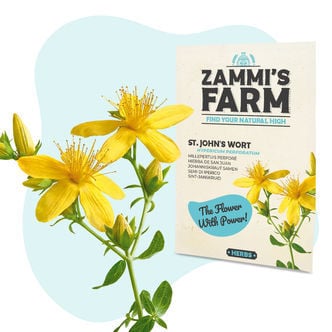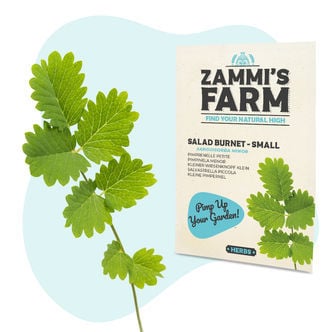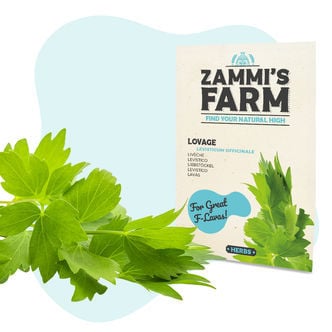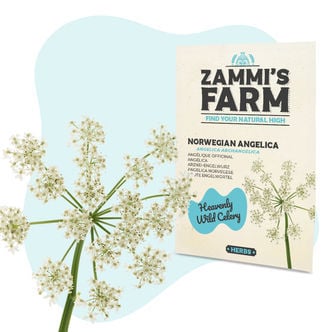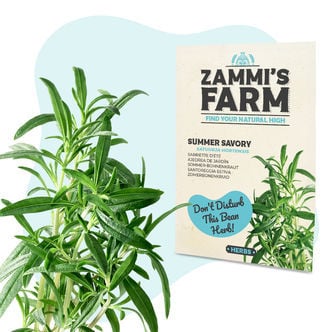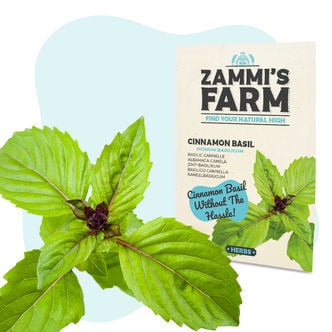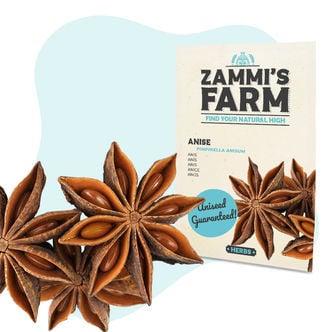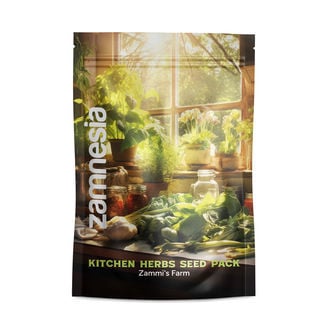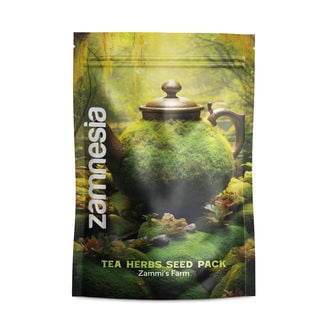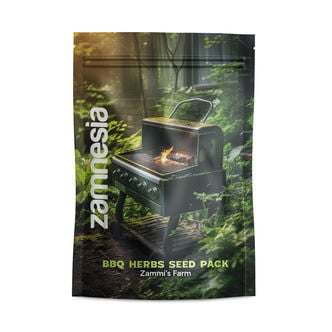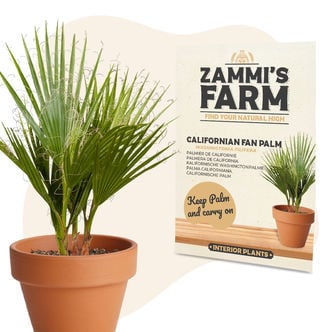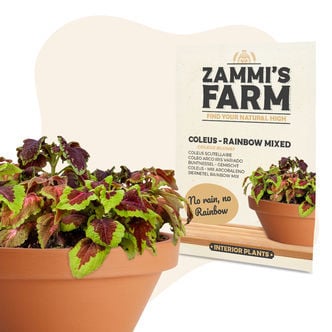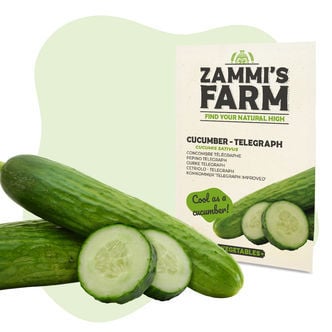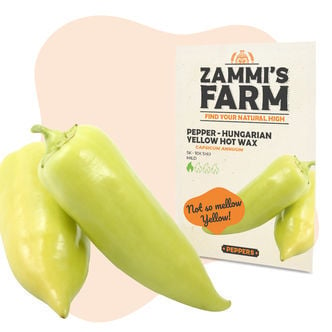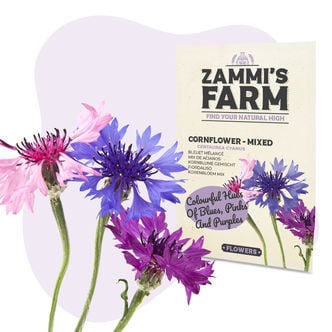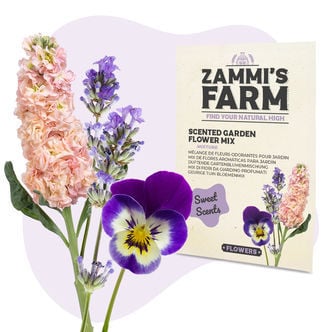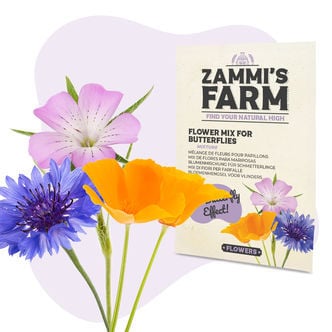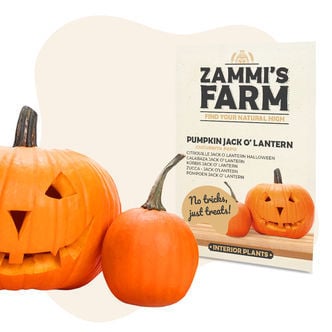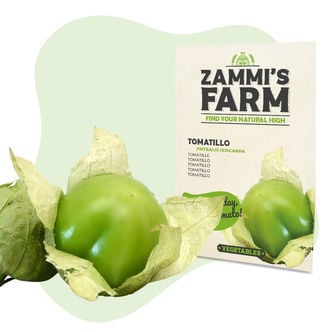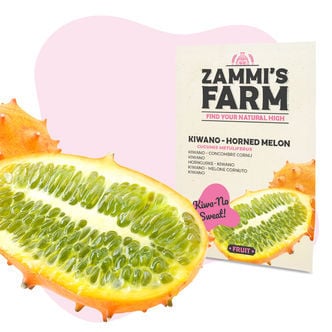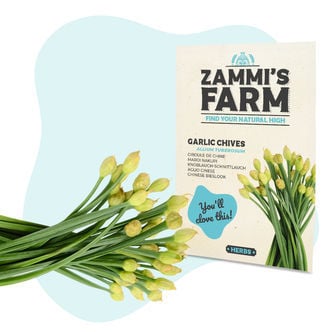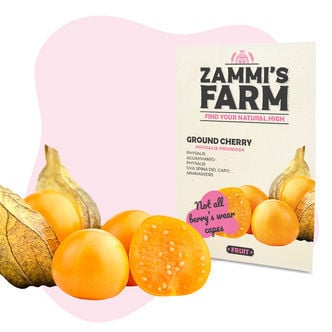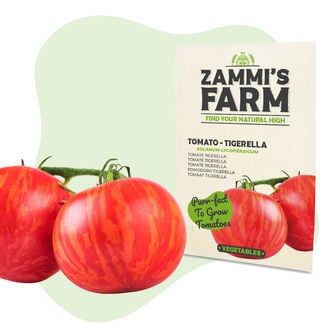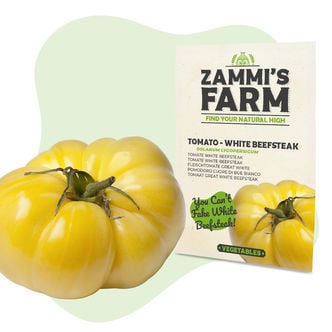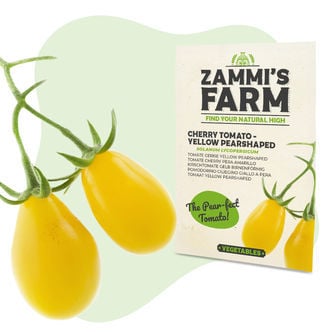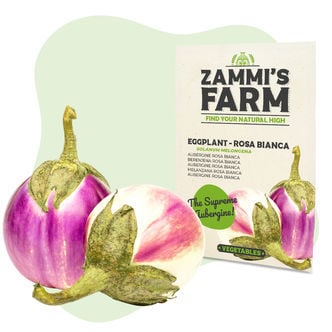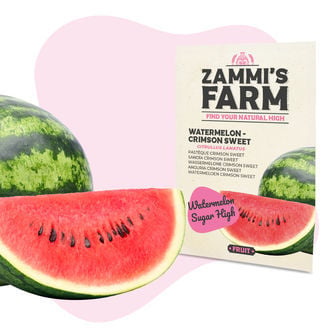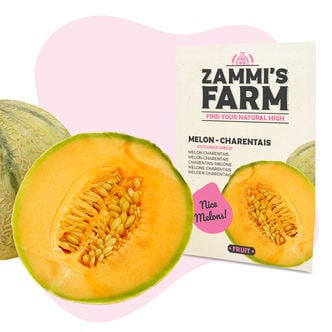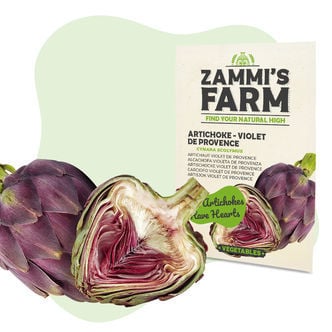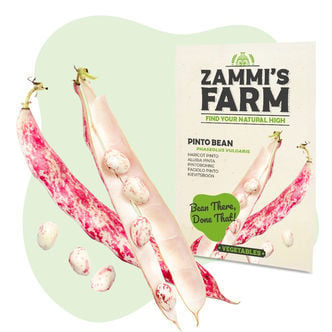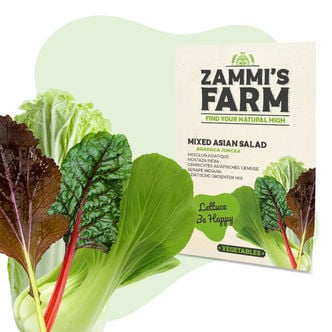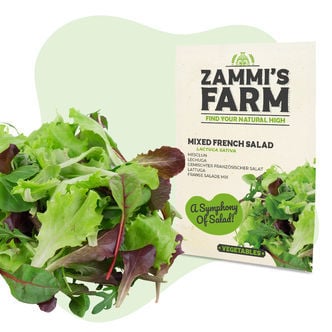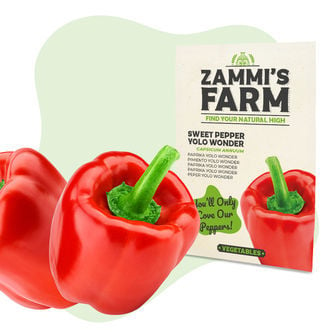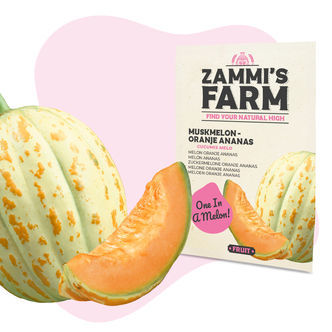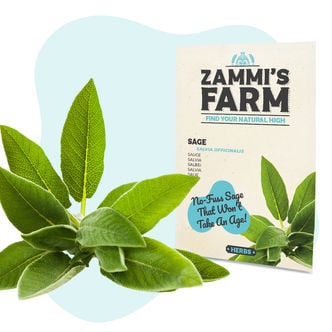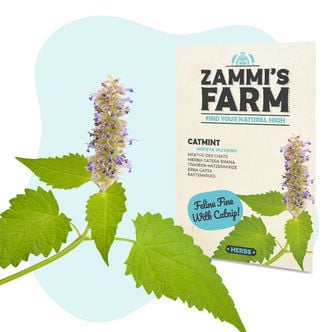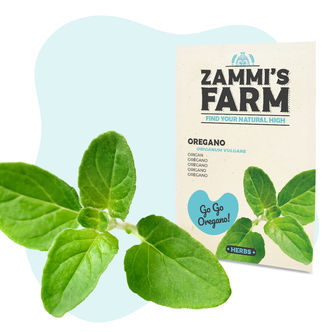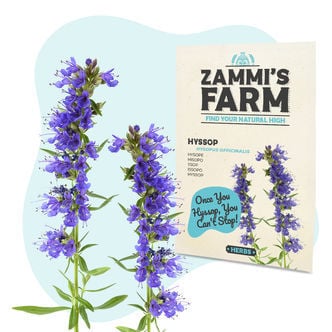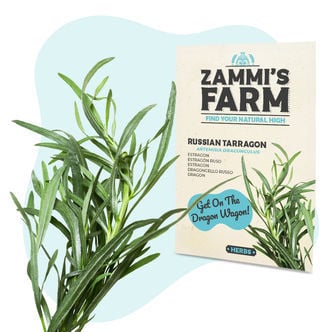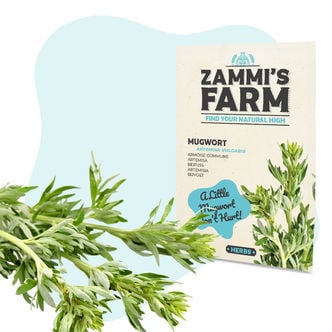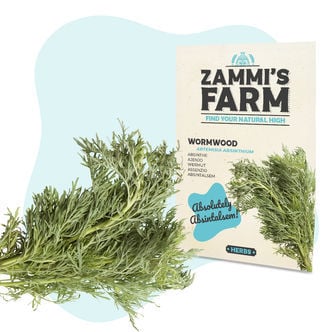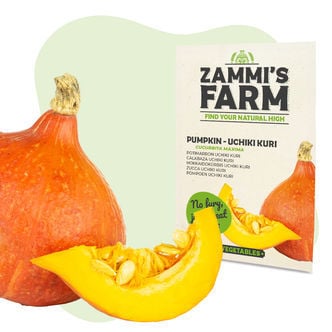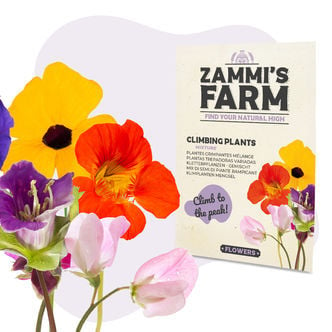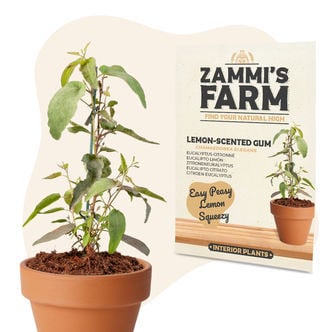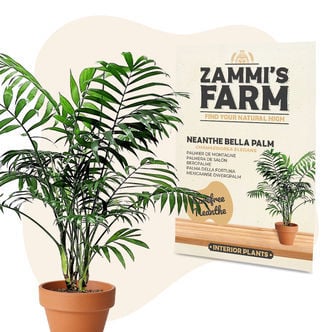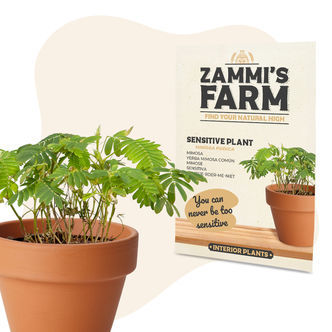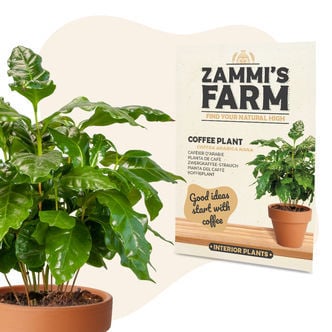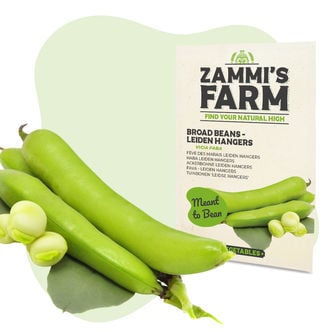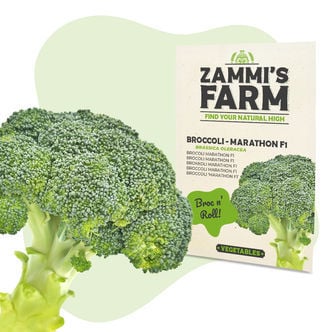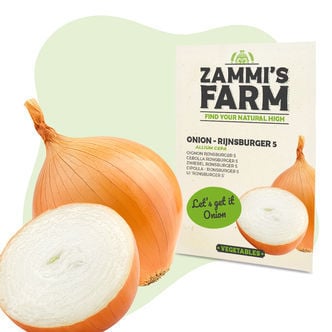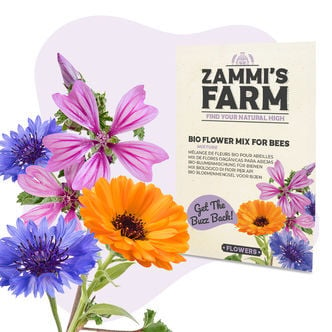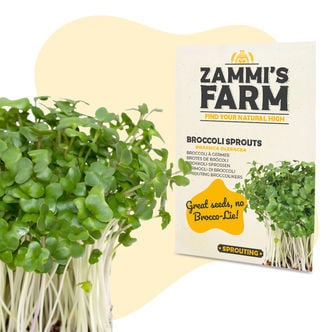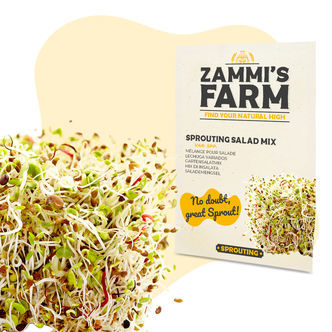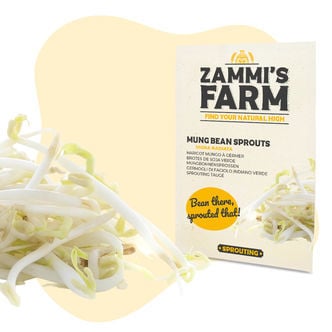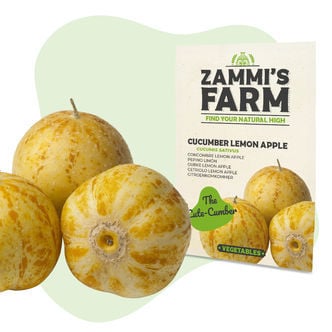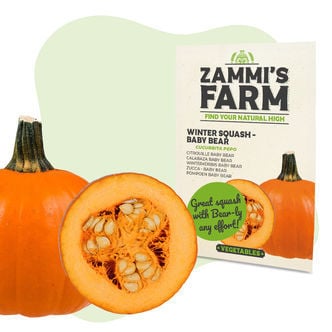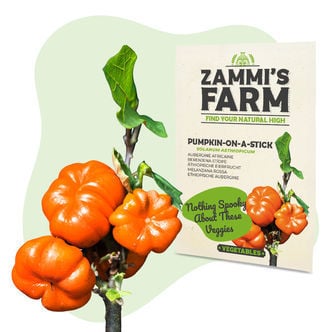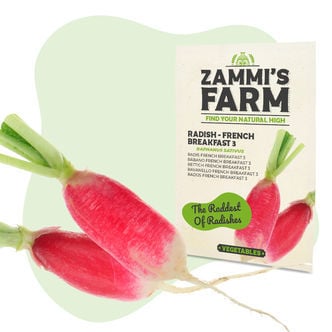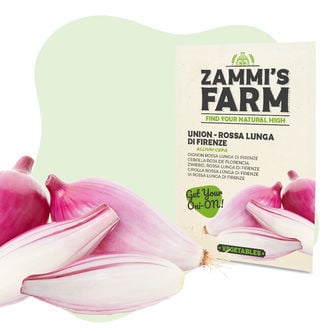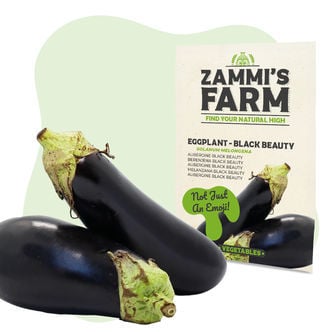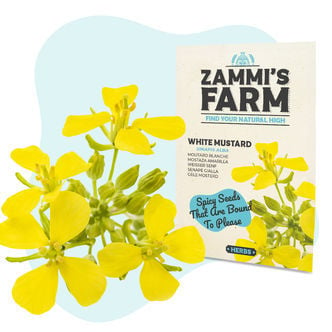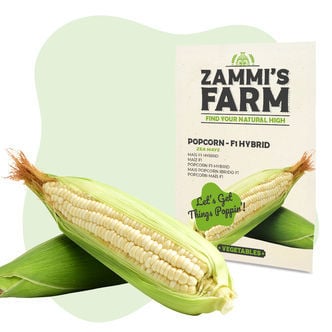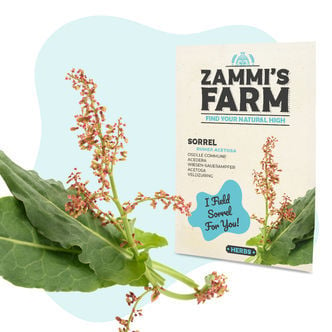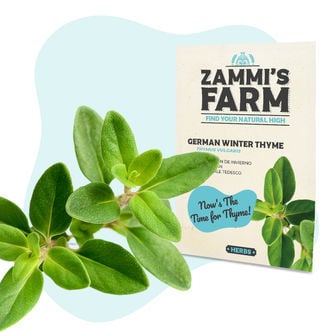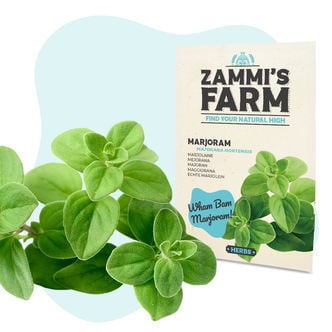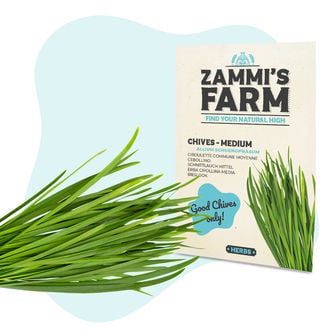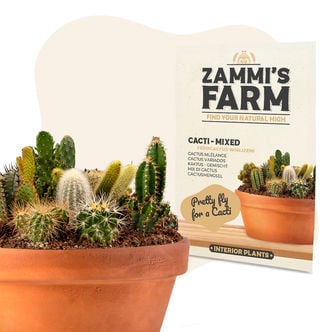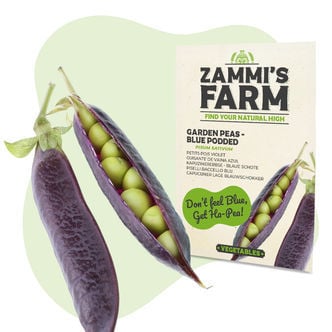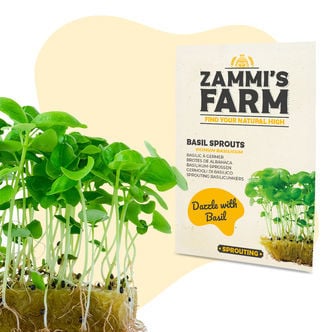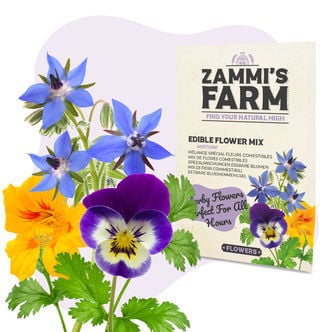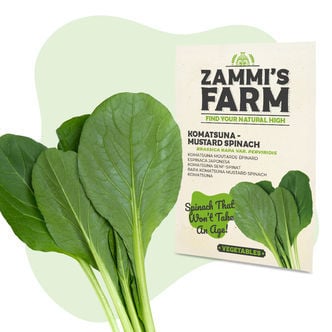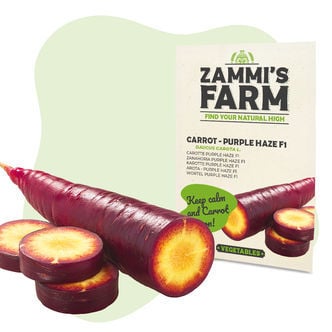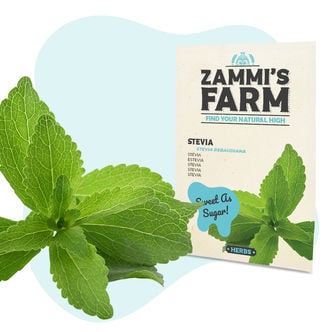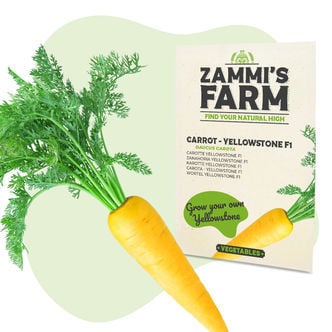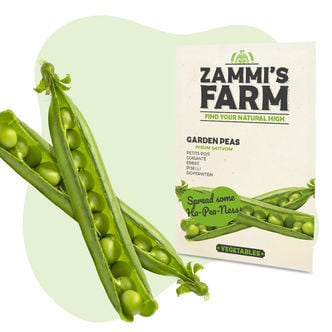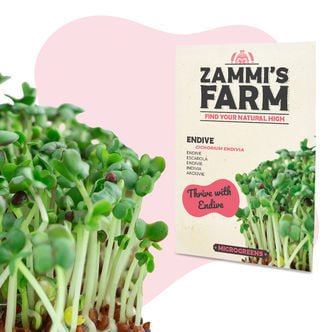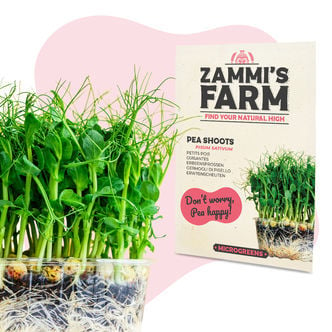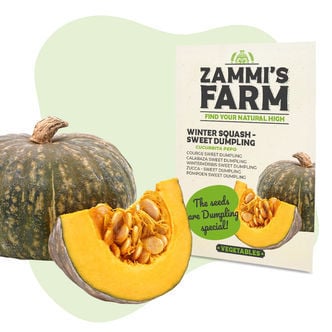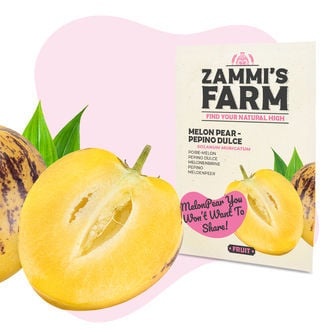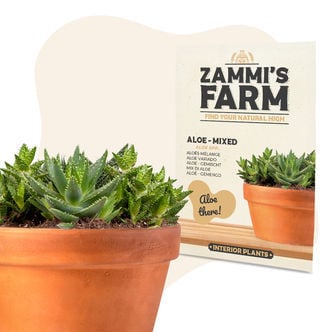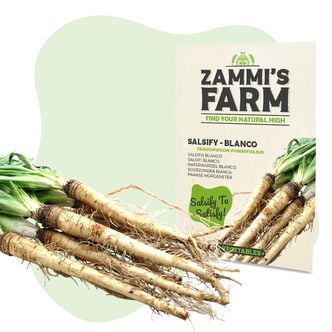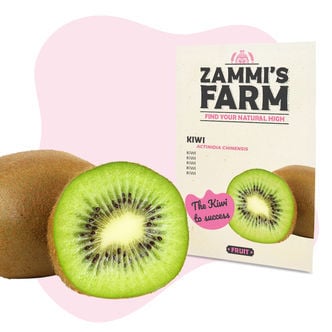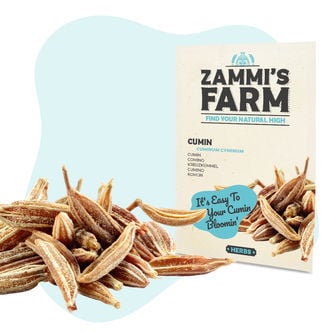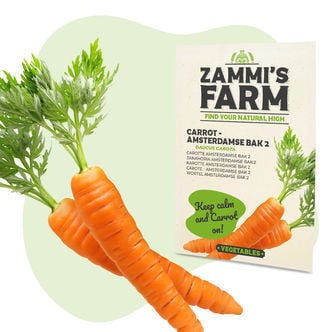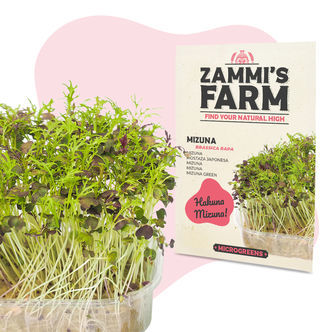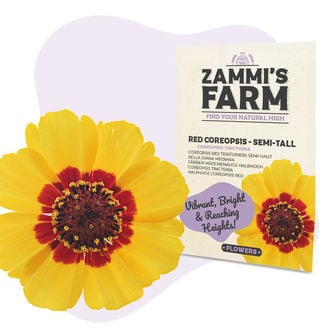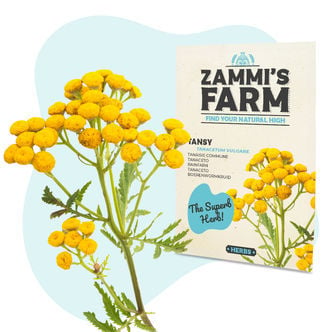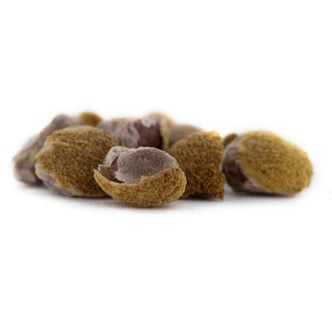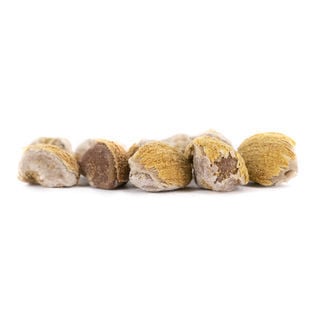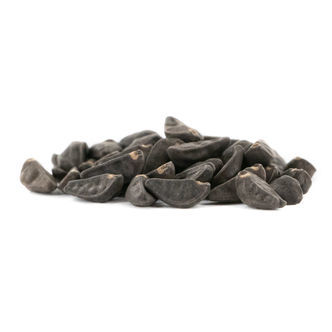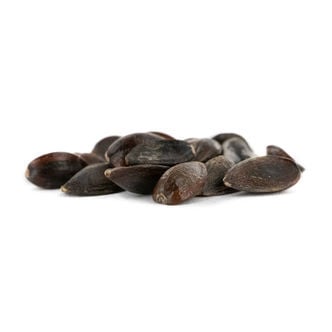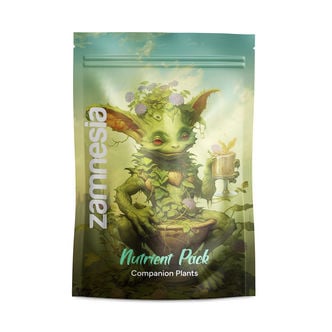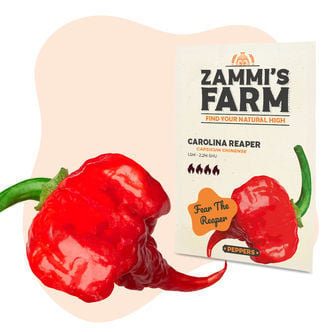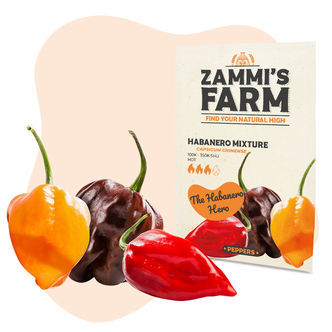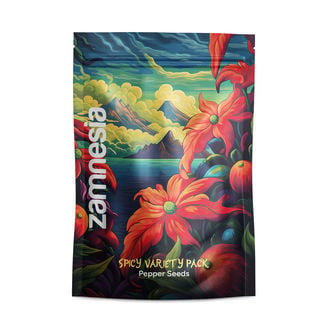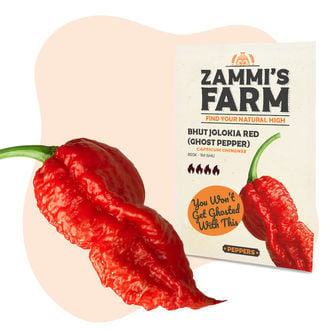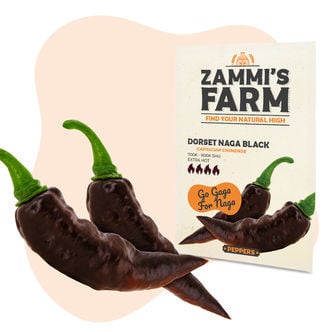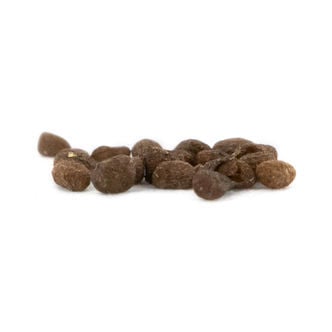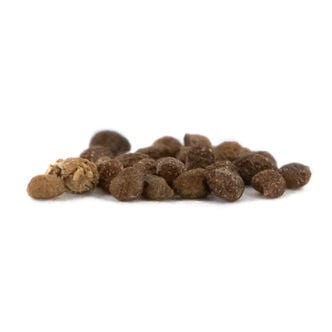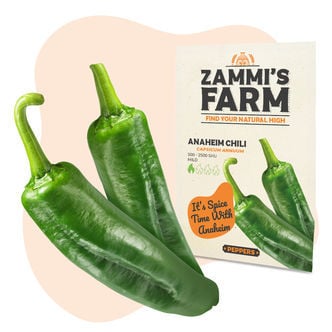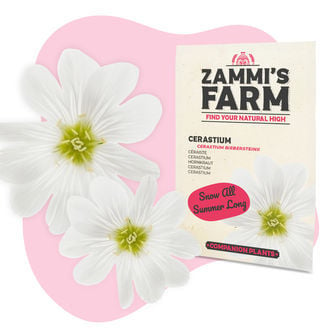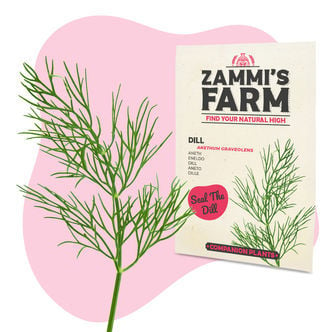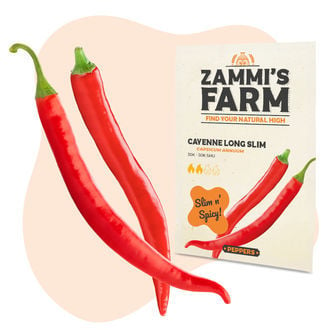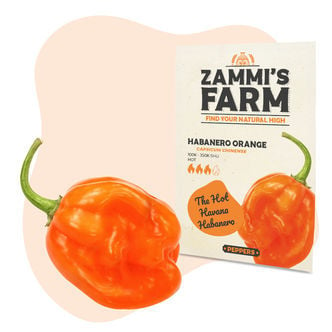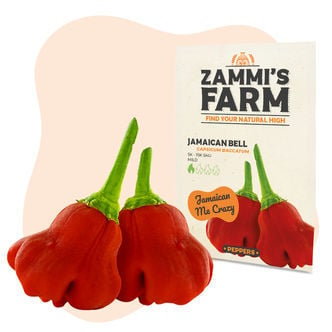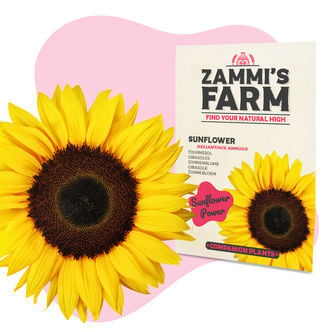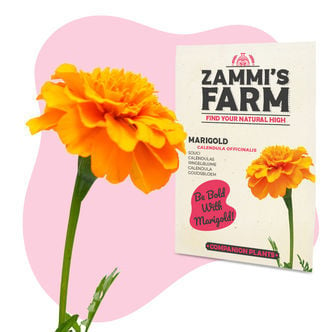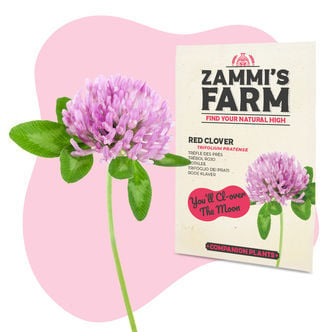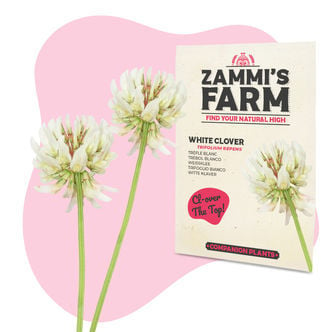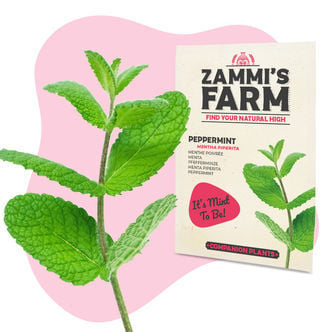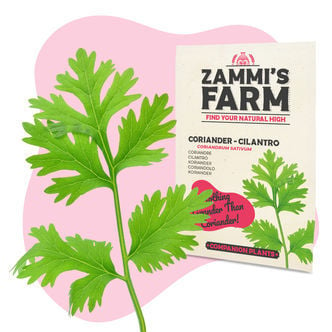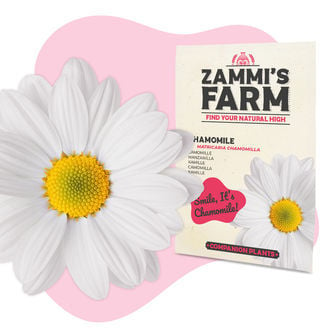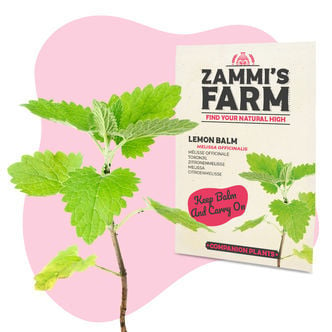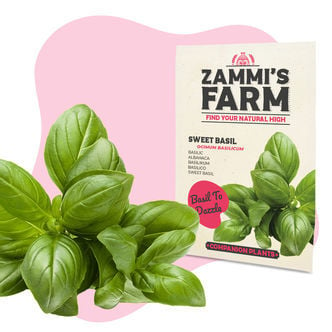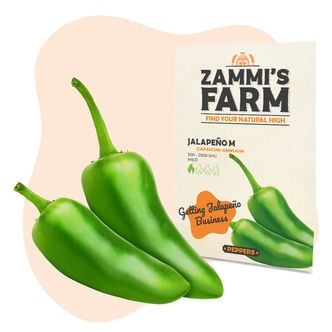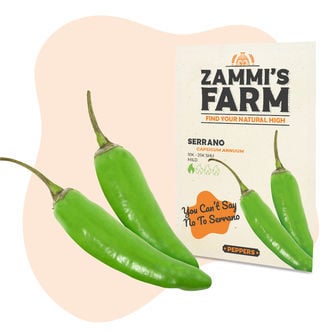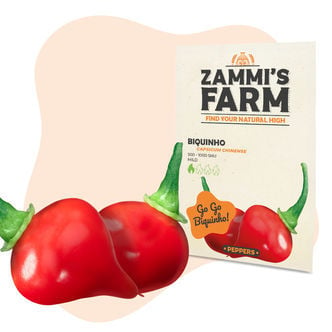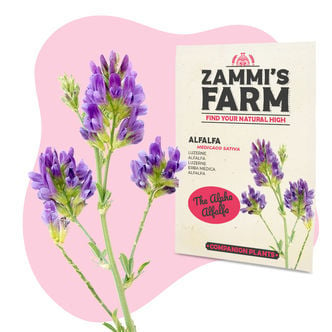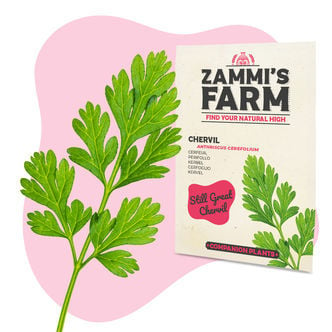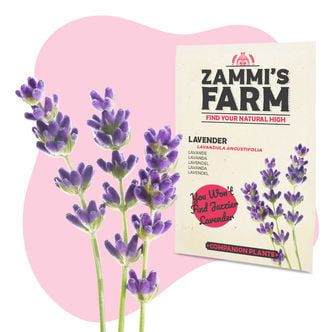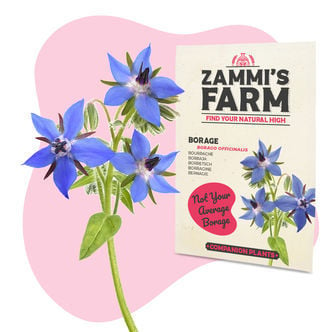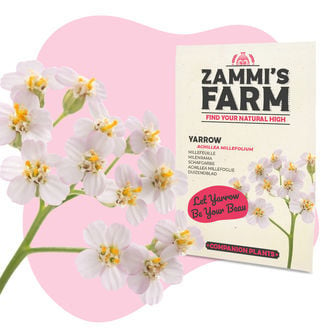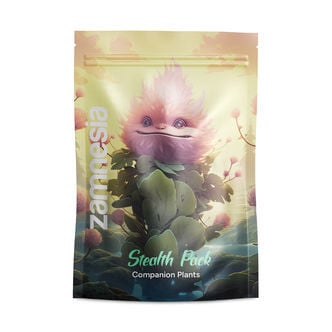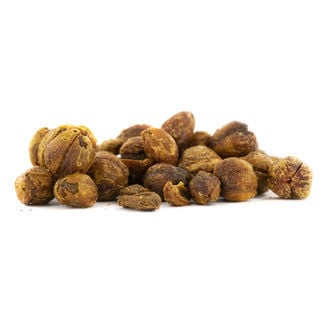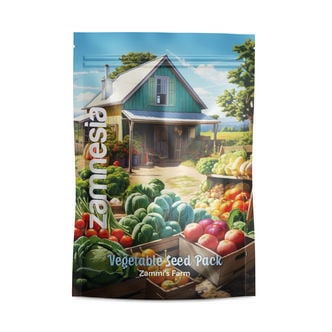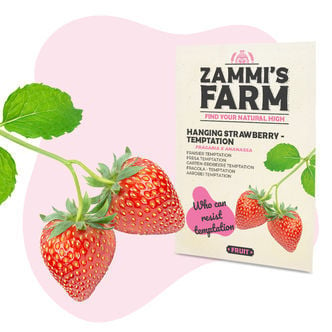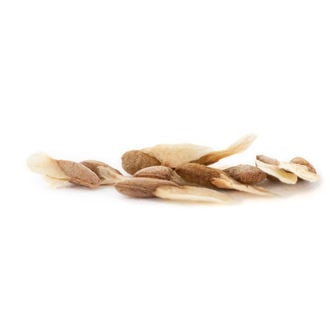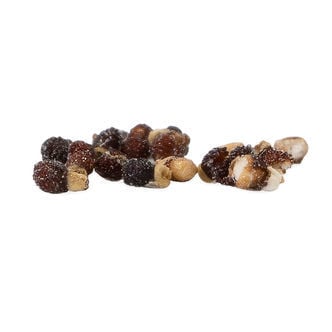All Seeds
There are 207 products.Want to give your garden a boost, but unsure of what to pick up? Have no fear! We've arranged all of our plant seeds in one place! This way, you can see exactly what's on offer, without the risk of missing anything. Whether you're looking to spruce up your growing space with colourful flowers or want to cultivate your own fruits and vegetables, we've got you covered.
With seeds catering for all experience levels and environments, you're sure to find at least one product that meets your needs and preferences. While certain varieties require a more hands-on approach, plenty of others offer a relaxed and easygoing cultivation experience. So, if you're thinking of getting into gardening, or rekindling a passion, let Zamnesia's Plantshop guide you to great plants that will flourish in no time.
St. John's Wort (Hypericum perforatum) Seeds
Hypericum perforatum, or St. John's wort, is an easy-to-grow perennial with beautiful star-shaped flowers. It grows best in full sun or partial shade, and can tolerate loamy or sandy soils, drought, and even flooding. Plant outdoors from early to mid-summer, and propagate St. John's wort from seed, division, or by taking soft-wood cuttings. Harvested flowers have a long history of holistic use.
Salad Burnet (Sanguisorba minor) Seeds
Salad burnet thrives in well-draining soil and is a hardy and robust plant whose leaves will be ready to harvest in late summer. Provide ample light, warmth, and water, and it'll reach heights of around 60cm. A plant favoured by such figures as Francis Bacon and Thomas Jefferson, it has a flavour that's perfect for sauces, dressings, and even summer drinks.
Lovage (Levisticum officinale) Seeds
Lovage seeds are best germinated indoors during spring, then brought outside once they have developed 2 sets of leaves and the last frost has passed. Transplant seedlings into fertile, deep, well-draining soil in full sun. Where possible, keep the soil slightly acidic (roughly 6.5 pH) and partly sandy/loamy with plenty of organic matter. Cook lovage leaves/roots or eat them raw in salads.
Norwegian Angelica (Angelica archangelica) Seeds
Norwegian angelica is a plant that originates from the Scandinavian region of Northern Europe. Producing edible stems that are similar to celery, it has plenty of uses in cooking, and the roots can even be used in gin distillation. Norwegian angelica requires consistently moist soil to flourish. Plant in spring, and it'll be ready to harvest come autumn.
Summer Savory (Satureja hortensis)
Summer savory (Satureja hortensis) belongs to the mint family and is a close relative of thyme and rosemary. It grows well in light, loamy soil with good drainage and plenty of sunlight. Leaves can be harvested as soon as plants reach 12.5–15cm tall, and are best consumed before the plants flower for a sweeter flavour. Summer savory makes a great seasoning for dressings, sauces, stews, and pies.
Cinnamon Basil (Ocimum basilicum) Seeds
Otherwise known as Mexican spice basil, cinnamon basil has a flavour reminiscent of its namesake, and is perfect for use in both sweet and savoury dishes. However, before that, you'll need to grow it! Cinnamon basil requires full sun and well-draining soil to perform at its best. It can reach over 1m in height, so start plants inside in the spring and let them flourish outside in the summer.
Anise (Pimpinella anisum) Seeds
Anise is best sown in early–mid spring in a sunny but sheltered spot. Germination can take between 3–4 weeks, but may be sped up by soaking seeds in water for a few days prior to planting. Pimpinella anisum hates cold and wet conditions, and likes well-draining, slightly acidic soil. Anise seeds can be harvested in late summer/early autumn and used in a variety of sweet and savoury dishes.
Kitchen Herbs Seed Pack - Zammi's Farm
Have a selection of practical and tasty herbs at your disposal with the Kitchen Herbs Seed Pack from Zamnesia. This curated selection of high-quality herbs is perfect for adding to a variety of dishes, and for using as a garnish on your plate too. These herbs are effortless to grow and can be cultivated on a kitchen windowsill for convenient placement when the time comes to use them.
Tea Herbs Seed Pack - Zammi's Farm
This selection of seeds has everything you need to make high-quality herbal tea from home. These plants are easy to grow and maintain, and after just a short cultivation cycle, you'll have access to a variety of herbs you can brew into delicious teas. With a host of potential wellness benefits, this finely tuned and carefully curated selection of seeds shouldn't be missed.
BBQ Herbs Seed Pack - Zammi's Farm
Prepare for BBQ season in the best way possible by growing your very own selection of herbs and plants. Whether you're making side dishes or looking to create rubs, marinades, or sauces, nothing's better than using ingredients you've grown yourself. The BBQ Herbs Seed Pack contains everything you need to make not only the BBQ foods of your dreams, but many other dishes too.
Californian Desert Fan Palm (Washingtonia filifera) Seeds
As the name suggests, the Californian Desert Fan Palm is from the far southwestern USA and Mexico, where it grows naturally in, you guessed it, the desert. Indoors, it grows well in sunny, warm spots to small sizes. In summer, feel free to bring your palm outside in the full sun to encourage further growth. Indoors, keep its soil moist and give her as much sun as possible.
Coleus - Rainbow Mixed (Coleus blumei) Seeds
Rainbow coleus adds lively colour to the home throughout all the seasons. Start these vigorous Coleus seeds off indoors in trays using well-draining, moist soil. Transplant your coleus plants to larger flower pots once they are 5-6cm tall. While the are intended to be grown indoors, Coleus blumei plants can be brought outside into a sunny spot during summer.
Telegraph Cucumber (Cucumis sativus) Seeds
There's nothing quite like the refreshing flavours of cucumbers. Whether added to salads or as a snack, Telegraph Cucumber (Cucumis sativus) is one versatile veg. Get these seeds started under glass from mid-March, provide some maintenance and upkeep, and come Summer, you'll have plenty of cucumbers to get your fill of. Leave around 40cm between plants and provide moist soil, and you're golden.
Hungarian Yellow Hot Wax Pepper (Capsicum annuum) Seeds
Sow your seeds in Springtime under glass and then migrate them outdoors when the time is right. Hungarian Yellow Hot Wax peppers are famously unfussy regarding maintenance and can perform well even in colder conditions, making them the ideal pepper partner for newcomers and experienced alike. Come Summer, you'll have a massive haul of moderately hot peppers that are perfect for pairing with a BBQ.
Cornflower 'Mixed' (Centaurea cyanus) Seeds
With an abundance of purple, blue, pink, and white hues, the cornflower (Centaurea cyanus) is one of the best options for brightening up your garden. Pleasing to the eye but overall undemanding, these plants will appeal to gardeners of all skill levels. Whether planted in borders or as wildflowers, these flowers will attract bees and other beneficial insects to your garden.
Scented Garden Flower Mix
Consisting of 15 flower varieties, this mix of seeds provides the perfect way to add fragrant aromas and a bevy of beautiful colours to your garden. Effortless to grow and resilient, simply sow your seeds in a place of your choosing, provide sufficient water, sun, and warmth, and they'll flourish with the greatest of ease. Thanks to their great aromas, insects will do the work of pollination.
Butterfly Flower Seed Mix
This seed mix contains seeds from a variety of vibrant flower species and has been specially formulated to attract butterflies into your garden or home and add a wild touch. Sow the seeds from early to late Spring outdoors directly where you want the flower to grow. All the flower varieties in this seed pack are annuals, like full-sun, and can be grown in the ground or pots/garden beds.
Pumpkin Jack O' Lantern (Cucurbita pepo) Seeds
Bred especially to be carved into Jack O' Lanterns, this beautiful orange, oblong Cucurbita pepo variety produces pumpkins that are very decorative yet still tasty, too. Sow your Jack O' Lantern seeds indoors in late winter, or directly outside in early spring. Like other pumpkin varieties, Jack O' Lanterns are best grown in fertile soil with stakes or trellises to accommodate their long vines.
Tomatillo (Physalis ixocarpa) Seeds
The Tomatillo or Mexican Husk Tomato dates back to the pre-Columbian era. It produces a spherical fruit with a green/purplish colour that looks similar to tomatoes but has a different flavour and texture. Tomatillo seeds are best sown indoors, and plants can be brought outside in Spring after the last frost. Tomatillo plants like well-draining soil, full sun, and regular organic fertilisation.
Horned Melon (Cucumis metuliferus) Seeds
Looks can be deceiving with this prickly fruit. It might look a little intimidating, but it's what's inside that counts. The Kiwano houses a sweet taste that's reminiscent of lemons and bananas. Perfect for fruit salads and desserts. Start your plants out in a greenhouse and then place them outside for full sun. A little hands-on grow-wise but manageable, it needs a warm climate or location.
Garlic Chives (Allium tuberosum) Seeds
Also referred to as Chinese chives and oriental garlic, garlic chives are a tasty herb with flavours reminiscent of its namesake. It's used in a wide variety of dishes, such as fish, salads, and soups. Before using them, though, you'll need to grow them! An easy affair, you can grow garlic chives both indoors and outdoors. Just give them moist soil and regular light, and watch them thrive.
Ground Cherry (Physalis peruviana) Seeds
Also known as the Cape gooseberry, Ph. peruviana is native to Chile and Peru, where it is commonly called aguaymanto, uvilla, or uchuva. A member of the Nightshade family, the Ground Cherry produces sweet fruits in a papery husk. Propagate these seeds indoors in early spring, then bring plants outside in early summer. Their fruit is ripe once it falls from the plant and can be eaten raw.
Tigerella Tomato (Solanum lycopersicum) Seeds
Boasting deep red skin with bright orange streaks, Tigerella tomatoes are a real sight for the eyes. This heirloom tomato variety (Solanum lycopersicum) is also very hardy and low-maintenance. Tigerella tomatoes grow well in full sun, and hold up well to mould and pests, though regular pest control is still recommended, as with all tomatoes. They produce aromatic, sweet fruit in 55-60 days.
Great White Beefsteak Tomato (Solanum lycopersicum) Seeds
The Great White beefsteak tomato is a real sight for the eyes, producing big, yellowish-white fruit. Pioneered by Thomas Jefferson in his garden in Monticello, these plants are best sown indoors 8 weeks before the last frost and brought outside once the threat of frost has passed. Grow Great White beefsteak tomatoes in full sun, fertilise regularly, and use stakes to support their heavy vines.
Yellow Pear Cherry Tomato (Solanum lycopersicum) Seeds
Besides their vibrant yellow colour, Yellow Pear Cherry Tomatoes (Solanum lycopersicum) boast a deliciously sweet, slightly acidic flavour. Sow your seeds in spring after the last frost and enjoy an endless supply of sweet cherry tomatoes all through summer. Yellow Pear tomatoes grow best in full sun and fertile soil. Fertilise plants regularly and use stakes or trellises to support their vines.
Eggplant 'Rosa Bianca' (Solanum melongena) Seeds
The Rosa Bianca eggplant variety (Solanum melongena) produces large, globe-shaped white fruit with beautiful lavender-purple streaks. Like other eggplant varieties, Rosa Bianca grows best in warm conditions and full sun. It likes fertile, moist, and acidic soil, occasional watering, and a hearty dose of phosphorus during flowering. Remember to mist plants regularly as soon as flowers appear.
Watermelon 'Crimson Sweet' (Citrullus lanatus) Seeds
The classic watermelon is perfect for enjoying at any time. Fresh and sweet, it goes great with breakfast or a post-dinner fruit salad. Now you can grow your own from the comfort of your home. While they can be a little tricky for newcomers, experienced gardeners will find them a breeze. Start them under glass in March/April, and they'll flourish over the summer. Harvest from July to October.
Melon 'Charentais' (Cucumis melo) Seeds
Fresh, sweet and perfect for breakfast, or well, anytime of the day, to be honest! Melon Charentais makes for a great growing project that yields some fruitful rewards. Start your seeds in a greenhouse or indoors, and then transplant them outdoors for the sunny summer months. Keep them well-watered, and they'll be happy for their entire growing cycle. Just try not to eat them all at once!
Artichoke 'Violet de Provence' (Cynara Scolymus) Seeds
Not only mindblowing in the flavour department, but Violet de Provence artichokes also showcase amazing looks that make it a must for any garden. Sow the seeds indoors between February and April, and place them outside in early summer. This is a perennial plant that will just keep going as long as you need it. Easy to care for, just cover in the winter months, and it'll usually look after itself.
Pinto Bean (Phaseolus vulgaris) Seeds
Pinto bean plants (Phaseolus vulgaris) grow like all other bean varieties but produce unique speckled beans. They like moist, fertile, loamy soil and full sun. Propagate your seeds after the last frost directly, roughly 4-6cm between each seed and use a pole, stake, trellis, or fence to guide the plants as they grow. Harvest pinto beans after roughly 45-60 days and use them fresh or dried.
Mixed Asian Greens Seeds
Get your seeds sown in early March, and by the end of August, the young leaves of the greens will be ready to harvest. A versatile combination of pak choi, taisai, tatsoi, turnip greens, chard, Chinese cabbage, leaf mustard and purple frills. All of these combine great flavours in a variety of dishes. Just be sure to provide plenty of light, warmth and moist loamy soil for best results.
Mixed French Salad (Lactuca sativa) Seeds
Perfect for a light summer meal, Mixed French Salad seeds grow into a mixture of red oak leaf lettuce, endive, radicchio, frisée, and arugula. Great for salads and undeniably tasty. Sow around May, and plants will be ready come September. Grow in moist, loamy soil with plenty of light and warmth for the best results. Reaching small heights, plants are easy to manage and care for.
Sweet Pepper Yolo Wonder (Capsicum annuum) Seeds
Related to the famous California Wonder, Yolo Wonder peppers are very resistant to disease and produce an abundance of sweet, crunchy peppers. Plant Yolo Wonder seeds in full sun in well-draining, fertile soil rich in organic matter, and roughly 45–60cm apart. Water regularly and feed flowering plants with a potassium-rich fertiliser. Prune/pinch foliage on young plants to encourage bushy growth.
Muskmelon 'Oranje Ananas' (Cucumis melo) Seeds
Sow muskmelon seeds outdoors after the last frost in full sun and moist, well-draining soil. Make sure to keep the soil moist (but not wet) at all times for proper germination. Space plants at least 30cm apart, and consider sowing multiple seeds in each spot and thinning the plants once seedlings emerge. Harvest fruits when their skin changes colour and they smell ripe and aromatic.
Sage (Salvia officinalis) Seeds
Germinate sage in late fall/early spring in an indoor propagator. Bring seedlings outside after the last frost, once they've developed their first set of true leaves. Plant in pots or garden beds in a sunny spot with well-draining soil. Regularly cut back plants and harvest their fresh leaves (which have the best taste) to encourage new growth. Use sage in cooking or to make herbal teas.
Catmint (Nepeta mussinii) Seeds
Catmint/catnip is very hardy and can be sown directly outside in late spring. It likes slightly acidic, well-draining soil and full sun. Although it appreciates regular watering, established plants can deal with moderate dry spells. Besides being loved by cats, catmint attracts pollinators into the garden while repelling mosquitos and cockroaches. Catmint can also be brewed into a wholesome tea.
Oregano (Origanum vulgare) Seeds
Grow oregano in well-draining pots or planters in full sun. Oregano plants suffer in moist soil, so water them only when their soil has dried out, and plant them in a light soil mix. Shelter oregano plants during long wet spells, and harvest fresh leaves regularly to encourage new growth. Use liberally in Mediterranean and Latin American cuisine for an intense, earthy, and warm flavour.
Hyssop (Hyssopus officinalis) Seeds
Hyssop, or Hyssopus officinalis, is part of the mint family and traditionally found in southern Europe and the Middle East. This shrub is quick to grow and needs to be sown in moist soil under full sun in the early summer months of June onward. With harvests as early as August, the flowers and leaves of this plant have a range of culinary and holistic uses worth exploring.
Russian Tarragon (Artemisia dracunculus) Seeds
Tarragon (Artemisia dracunculus) has been cultivated for culinary purposes since at least 500 BCE. This hardy perennial plant likes growing in full sun and fertile, well-draining soil (though it can grow fine even in sandy/loamy soil). Germinate tarragon in spring, and space plants appropriately to accommodate their fast-growing roots. Ideal for adding to salads, marinades, condiments, and more.
Mugwort (Artemisa vulgaris) Seeds
Artemisa vulgaris likes warm, sunny spots with well-draining, dry soil. Mugwort is a hardy, drought-tolerant plant that grows well in slightly shaded areas and in both acidic and slightly alkaline soil. Mugwort seeds are best germinated in a propagator or outdoors in spring after the risk of frost passes. Fresh mugwort can be used to season stocks, broth, and game, and as a herbal tonic.
Wormwood (Artemisia absinthium) Seeds
Artemisia absinthium (wormwood) seeds are best germinated in a propagator in early spring, or in garden beds between mid-spring and early summer. Remember to thin out your crop and grow absinth in full sun and well-draining soil. Avoid overwatering; Artemisia absinthium has a high tolerance for drought. It can be used to flavour alcoholic beverages, control garden pests, and make herbal tonics.
Exotic Seed Pack - Zammi's Farm
This pack of exotic plant seeds contains a range of seeds that will allow you to grow a weird and wonderful array of fruit and veg in your garden! If you want to grow plants that look great, and taste great come harvest time, you're in luck! Impress yourself and your friends with the Exotic Seed Pack.
Wellness Seed Pack - Zammi's Farm
This pack of wellness plant seeds allows you to grow traditional botanicals in your very own garden! With a variety of seeds, you can cultivate a selection of plants that you can use in a range of different situations. How good will it feel to head out to your garden and pick some leaves or flowers to use in your own holistic preparations? Well, you'll soon find out.
Fruit Seed Pack - Zammi's Farm
This variety pack of fruit seeds gives you the opportunity to grow a range of succulent and refreshing fruit in your very own garden. These fruits will keep your palate excited and your body packed with beneficial nutrients! And the plants themselves will decorate your garden with the diverse splendour of a range of fruits from across the world.
Pumpkin Uchiki Kuri (Cucurbita maxima) Seeds
Uchiki Kuri, also known as Red Kuri, is a bright orange squash variety. Seeds can be sown in spring outdoors directly in seed beds. Mature plants like rich organic soil, so prepare the soil with compost or manure or fertilize regularly. Besides being very decorative, Uchiki Kuri squash boasts sweet flesh that goes great in sweet and savoury recipes.
Climbing Flowers Seed Mix
Got a fence or trellis that you want to decorate with some colour? This seed mix contains a wide variety of climbing flowering plants. Sow them between mid and late spring in thin rows directly where you want the flowers to grow. As they grow, gently coax the growth onto/around the trellises/fences in your garden and watch them shine with colour in no time!
Lemon-Scented Gum (Eucalyptus citriodora) Seeds
Though native to Australia, you don't have to go down under to bask in the beauty of the Lemon-scented Gum Tree. These Eucalyptus citriodora seeds are super hardy and can be grown indoors all over the world all year round. Start your seeds off when it's warm and keep mature plants in full sun and enjoy their natural citronella aroma - great for keeping mosquitoes at bay.
Neanthe Bella Palm (Chamaedorea elegans) Seeds
Commonly known as the Parlor Palm, Chamaedorea elegans may be native to Central America but has since taken over homes all over the globe. With their deep green foliage, these palms are stunning all year round. Start your seeds when it's warm (25º) in moist seed trays and be patient—Parlor Palm seeds can take up to 100 days to germinate! Parlor Palms like bright spaces away from direct sunlight.
Sensitive Plant (Mimosa pudica) Seeds
Known by many different names, including the Sensitive Plant, Sleepy Plant, and Touch-Me-Not, Mimosa pudica is an annual plant belonging to the pea and legume family. This variety can be grown all year round, and seedlings are best started indoors in spring. Native to central & south America, these plants like warm, sunny, and humid environments and are known for closing their leaves when touched.
Coffee Plant (Coffea arabica nana) Seeds
Ever wanted to grow your own coffee plant but thought it was a tall order? These Coffee Plant (Coffea arabica nana) Seeds make for the perfect home-growing project. This plant is simple to grow and can be cultivated year-round; all it takes is 50 days of gemination. This plant makes for a showstopping feature in your home and if grown right, has the potential to produce berries.
Broad Bean Leidse Hangers (Vicia faba) Seeds
Broad beans are not only delicious but also super healthy. This fast-growing and resistant variety can be planted in early spring or fall and produce plentiful harvests of long, sweet beans filled with 5-6 pods. Blanched, stir-fried, or in soups and stews, these delicious beans make a great addition to a variety of meals. Plus, they can also be frozen fresh and keep for months in the freezer.
Broccoli Marathon F1 (Brassica oleracea) Seeds
Marathon F1 Broccoli (Brassica oleracea) seeds produce hardy plants that yield large, tender, and delicious Broccoli heads. Start your seeds in early to mid-spring for a summer crop, and in late summer for an autumn harvest. Remember that broccoli likes full sun but hates the heat, which causes it to bold and produce flowers rather than luscious heads.
Onion - Rijnsburger 5 (Allium cepa) Seeds
If there's a vegetable that has got to be a staple in every kitchen, it is the noble onion (Allium cepa). For the best results, start onions off indoors during late winter, and trim their tips when they're about 7–8cm long. Bring them outside in spring to grow in the sun till the end of summer, when they'll start focusing their energy on bulb production.
Organic Flower Seed Mix for Bees
Give both yourself and the bees a treat with our Organic Flower Mix for Bees. This seed mix contains nectar-centralised species of flowers that are irresistible to bees. Not only serving for pollination, but the flowers are also great looking and aromatic too. Bound to spruce up any garden space effortlessly. Sow them in April and allow the plants to flourish all summer. It really is that easy.
Broccoli Sprouts (Brassica oleracea) Seeds
Whether you like them in your smoothie, salad or sandwich, there's no denying the rich antioxidants and tasty flavours of Broccoli Sprouts. They're also incredibly simple to cultivate. Sow the seeds in a pot in early Spring and give them plenty of sun, warmth and a little water now and again, and they'll flourish effortlessly. Come August, they'll be ready to harvest and can be enjoyed instantly.
Sprouting Salad Mix Seeds
Jump on the bandwagon and grow sprouts at home with the Sprouting Salad Mix—healthy and delicious mung bean, alfalfa, lentil, fenugreek and yellow mustard sprouts. Grow them in a sprouting jar or one with muslin tied over the top. Soak your seeds for about 8 hours and drain thoroughly. Rinse and drain twice a day, when you see sprouts, leave in a well-lit area until they reach the desired size.
Mung Bean Sprouts (Vigna radiata) Seeds
Vigna radiata, commonly known as the mung bean, is a delicious and highly nutritious legume ideal for stewing or slow cooking. Mung bean sprouts, on the other hand, are fresh and watery, ideal for summer salads or stir-frying. Plus, growing them couldn't be easier; just sprout the beans in damp paper towels and use them when they're about 4–5cm long!
Lemon Apple Cucumber (Cucumis sativus) Seeds
Perfect for salads, the lemon apple cucumber has a slightly sweet flavour that's refreshing and moreish. All it takes is a little gardening know-how, and you'll have some fantastic fruits at your disposal. Get the seeds started under glass, and allow the plants to flourish until late summer. Then, you can harvest and enjoy the yellow, apple-shaped fruits of your labour. Delicious!
Winter Squash Baby Bear (Cucurbita maxima) Seeds
Baby Bear Winter Squash (Cucurbita maxima) is a must-have for every veggie patch. Germinate your seeds indoors and bring them outside in the spring. Plant Baby Bear squash in soil with plenty of manure or compost to ensure healthy growth and the production of large, sweet fruit. Use tutors, stakes, or trellises to grow Baby Bear Squash vertically in smaller spaces.
Pumpkin on a Stick (Solanum aethiopicum) Seeds
What can we say about pumpkin on a stick? The name is the biggest clue! These veggies are perfect for adding to cooking, as both the fruit and leaves can be eaten. However, some even opt to use pumpkin on a stick as part of a flower arrangement, giving it plenty of applications for all. Get them started early indoors, and then let them bask in the summer sun. Easy.
Radish 'French Breakfast 3' (Raphanus sativus) Seeds
Crisp and crunchy are just words to describe the French Breakfast 3 variety of radish. They offer up a great "snap" when eaten and have a fresh flavour that's perfect for blending with other vegetables. In fact, it's even recommended that these seeds are sown next to carrots or lettuce to give them a good biological balance. Begin them in March, and they'll be good later in the summer.
Onion 'Rossa lunga di Firenze' (Allium cepa) Seeds
Rossa lunga di Firenze is a unique onion cultivar originating from Tuscany, Italy. It is best sown in rows outdoors during spring in fertile, well-draining soil and full sun. Thin seedlings after 6 weeks. Where possible, keep soil pH between 6 and 6.8 (though not crucial). The "Long Red of Florence" takes approx. 4 months to mature and produces mild-flavoured, elongated onions best eaten fresh.
Eggplant 'Black Beauty' (Solanum melongena) Seeds
Whether you know it as eggplant or aubergine, one thing's for sure; this is a hugely versatile and tasty vegetable, no matter how you use it. Named Black Beauty for its dark skin, all it takes is a matter of months for ripe fruits to be ready for the picking. Start in a seed tray indoors or in a greenhouse, then move outdoors to let them thrive until harvest time in late summer.
White Mustard (Sinapis alba) Seeds
White mustard (Sinapis alba) is versatile. Use the seeds in cooking, sauce making and pickling, and the young leaves in salads and other dishes. The choice is entirely up to you. If you're looking to grow, sow the seeds in March, and they'll be ready in the summer. Generally low maintenance, all it takes is just some moist soil and the standard light and warmth, and you'll be golden.
Popcorn (Zea mays) Seeds - F1 Hybrid
Zea mays, sweet corn, or popcorn is an ancient crop that grows well in home gardens. It loves full sun and well-draining, moist, and fertile soil (preferably with a neutral or slightly acidic pH). Sow Zea mays in blocks to ensure effective wind pollination to harvest full cobs. Harvest Zea mays when the tassels at the end of the plant's cobs turn black, and use in your favourite recipes.
Sorrel (Rumex acetosa) Seeds
Sow sorrel (Rumex acetosa) seeds in light, warm soil in spring (after the last frost). Common garden sorrel likes damp soil, so water regularly while being diligent not to flood the plant's roots. Trim sorrel plants regularly during the growing season to encourage healthy, bushy growth. Sorrel can be eaten fresh in salads or cooked and puréed to make sauces, soups, or Asian curries/stews.
German Winter Thyme (Thymus vulgaris) Seeds
A perennial plant originating from the Mediterranean, German winter thyme, also known as Thymus vulgaris, requires full sun to really flourish. This is a bushy plant that can become a mainstay in your garden for many years under the proper care. Planting in loamy, well-draining soil is the key to success here. Once ready, the herb is ideal for culinary use in a similar way to oregano and sage.
Marjoram (Majorana hortensis) Seeds
Majorana hortensis, or sweet marjoram, loves sunlight just as much as oregano, its closely related cousin. Start marjoram seeds in a propagator or directly outdoors in spring (after the last frost). Marjoram also likes loose, well-draining, and moist soil, though established plants are fairly drought-tolerant. Marjoram is a great seasoning for pork, poultry, and a variety of vegetables.
Chives 'Medium Fine' (Allium schoenoprasum)
Chives are best started indoors and brought outside in spring after the last frost, once they are about 4" (10cm) tall. They thrive in half-shade and like fertile, well-draining soil with plenty of organic matter. Make sure to keep the soil moist (especially during long dry spells in summer) and harvest fresh leaves regularly to encourage new growth. Ideal for seasoning various savoury dishes.
Cacti Mix (Ferocactus wislizeni) Seeds
Grow cacti from seed all year round with our Cacti Mix (Ferocactus wislizeni) Seeds. Soak your seeds for a day and sow indoors by sprinkling over the soil and gently pressing into it. Maintain moist for germination and place the pot or container in a warm spot. Be patient, as cacti take time to germinate and grow. Cultivators recommend adding sterilised perlite to your soil mix.
Blue Podded Pea (Pisum sativum) Seeds
These veggies are ideal for all kinds of dishes and deliver great flavours each time. Growing the Blue Podded Pea is also a cinch, regardless of your environment. Sow the seeds as early as February and watch as they flourish through to June-July. Once at this stage, they're ready for the picking. Just be sure to keep the soil moist but not overly and provide plenty of light. You can't lose.
Basil Sprouts (Ocimum basilicum) Seeds
Basil (Ocimum basilicum) is a beloved, highly fragrant herb. But did you know that basil sprouts are equally delicious yet much more nutritious? To grow yours, simply sow seeds at a high density in a propagator and harvest your sprouts after roughly 10 days. Use just as you would normal basil, with the same great taste but much more nutrients!
Edible Flower Mix Seeds
Ideal for garnishing dishes and adding beauty to any garden, this Edible Flower Mix is just the ticket. Consisting of a selection of edible flowers such as Althea rosea, borage, Viola, and Aztec marigold, among others, sow the seeds in early March and provide regular sunlight, water, and upkeep. Soon, you'll be rewarded with a bevy of beautiful flowers you can use however you’d like.
Komatsuna (Brassica rapa var. perviridis) Seeds
Komatsuna is a unique variety of Mustard Spinach (Brassica rapa), also known as Japanese Mustard Spinach. Like other spinach varieties and leafy greens, Komatsuna seeds are best sown outdoors in nitrogen-rich, moisture-retentive soil. Mulching is recommended to help the soil retain more moisture. Seeds can be sown from early spring to autumn. Harvested leaves can be eaten fresh or cooked.
Purple Haze F1 Carrot (Daucus carota L.) Seeds
Get yourself in a purple haze with these plum-coloured carrots! Purple on the outside and orange in the centre, these veggies are certainly eye-catching, but they're also sweet and suitable for salads, as a side or as a snack. They're versatile not just in the kitchen but in the garden too. Sow these easygoing seeds directly into the ground and let them soak up the sun and warmth until ready.
Stevia (Stevia rebaudiana) Seeds
Stevia rebaudiana or sugarleaf is very easy to grow. Germinate seeds indoors and bring them outside in mid-summer. Plant stevia in full sun in well-draining soil with a pH of 6.7-7.2. Feed plants regularly with a natural liquid fertilizer or nitrogen-rich organic fertilizers like compost, worm castings, guano, or something similar to fuel healthy leaf growth. Use stevia as a natural sweetener.
Yellowstone F1 Carrot (Daucus carota) Seeds
Add some bright yellow magic to your garden with these Yellowstone F1 Carrot (Daucus carota) Seeds. Simply sow these seeds directly into the ground in March and keep the soil moist throughout their growing cycle. When August rolls around, you'll be met with a whole bunch of yellow carrots that are perfect for a wide variety of dishes and meals. What could be better than that?
Garden Peas (Pisum sativum) Seeds
Sow these delicious peas in early to mid-spring directly outdoors. These hardy plants will grow roughly 150cm tall with many tendrils, so they're best supported with trellises and stakes. Harvest your peas while they are still juicy and enjoy them fresh or cooked in everything from salads and stir-fries to soups and stews.
Microgreens Endive (Cichorium endivia) Seeds
Ideal for being added to salads, soups and a variety of dishes, the Microgreens Endive have long been used since the days of ancient Greece! Rich in vitamins K and C, you too can now enjoy the great flavours. Seeds take 2–3 days to germinate, and the earliest leaves that sprout around the 8–15 day mark are perfect for picking. Give them moist soil, some sunlight and warmth, and they'll perform.
Microgreens Pea Shoots (Pisum sativum) Seeds
To get the best out of your Microgreens Pea Shoots, simply sow the seeds in early Spring, and they'll be fast to flourish. Able to be grown in warm outdoor spaces or in a small windowsill or balcony space, keep the soil moist throughout but not waterlogged, and these sweet leaves will begin to appear pronto! Enjoy rich flavours that are ideal to accompany salads, soups and sandwiches. Perfect.
Winter Squash Sweet Dumpling (Cucurbita pepo) Seeds
Sweet Dumpling is a delicious variety of winter squash (Cucurbita pepo) with a hard, cream-coloured rind and tender, sweet flesh. Growing to roughly the size of a grapefruit, Sweet Dumpling squash make a great addition to any veggie patch. Start seedlings off indoor in late winter or directly outdoors in early spring. Like other squashes, plant Sweet Dumpling squash in highly fertile soil.
Melon Pear (Solanum muricatum) Seeds
Melon Pear (Solanum muricatum), commonly called Pepino Dulce (sweet cucumber in Spanish), is a shrub native to South America. It produces sweet fruit with the looks and texture of a melon and a succulent flavour similar to honeydew. Melon Pear is super easy to grow, thriving in temperate climates, full sun, and rich soil with a neutral PH. Harvest when the fruit develops purple streaks.
Aloe - Mixture (Aloe spp.) Seeds
Our mixed Aloe seeds can be sown and grown all year round. Just start your seeds off in moist soil at roughly 20°C. Once a few sprouts appear, thin them out and wait for them to reach 5-6cm before you prick them apart and plant them in separate spots. Aloe vera not only looks great but also has many benefits for the skin and can be used to alleviate sunburn and other skin damage.
Salsify 'Blanco' (Tragopogon porrifolius) Seeds
Salsify (Tragopogon porrifolius) has long been cultivated in England, Belgium, and France. Sow salsify seeds directly outdoors, leaving 8-10cm between plants and 30-40cm between rows. Salsify likes deep, loose, and fertile soil with plenty of organic material, full sun, and regular watering (especially in warm climates). Harvest roots before plants bloom, followed by shoots and flowers.
Kiwi (Actinidia deliciosa) Seeds
Germinate seeds in a clear ziplock bag on a damp paper towel. Keep in a warm place until seeds sprout (2 weeks approx.), then put into small pots. Seedlings like a warm, sunny environment and slightly acidic soil. After 3–4 months they can be transplanted into bigger pots or garden beds outside. Kiwi is a vine, so prepare to train and support plants as they grow. Plants bear fruit after 4–6 years.
Cumin (Cuminum cyminum) Seeds
Cumin needs long, hot seasons to produce seeds to propagate and use in cooking. Start your seedlings off early (4 weeks before the last frost), and bring them outside once temperatures sit above 15°C. Grow your plants in full sun and water sparingly. They'll begin flowering in mid-summer and be harvest-ready after roughly 120 days. Use dried cumin seeds to season meats, stews, curries, and more.
Carrot Amsterdamse Bak 2 (Daucus carota) Seeds
Getting your hands on some sweet, delicious carrots has never been easier with our Carrot Amsterdamse Bak 2 (Daucus carota) Seeds. Start these seeds off under glass indoors in early Spring and then move outdoors so they can soak up the warmth and light that Summer provides. Just ensure they're well looked after, and they can't do you wrong. Enjoy large yields of sweet-tasting carrots come Summer.
Microgreens Mizuna (Brassica rapa) Seeds
These fast-to-flower Asian leaves can be cultivated in a wide variety of settings and environments. They are typically low maintenance and suit growers of all skill sets. Sow the seeds in early Spring and enjoy them after just a few weeks of flourishing. Microgreens Mizuna has a mustard-like flavour that's ideal for adding to salads and other dishes for a little spicy snap.
Red Coreopsis (Coreopsis tinctoria) Semi-Tall
Give your garden some deep red hues with Red Coreopsis (Coreopsis tinctoria) seeds. These massively resilient and robust flowers make the perfect addition to any garden. Suitable for home growers and gardening experts alike, these tough plants can withstand pretty much any environment, and require little in the way of maintenance. Plant, and go!
Tansy (Tanacetum vulgare) Seeds
Also known as bitter buttons, cow bitter, and golden buttons, the tansy is a perennial, herbaceous flowering plant that's bright, colourful, and bound to add vibrancy to any garden. Thanks to its resilience, it can be cultivated in a wide range of environments. Provide full sun and well-drained soil, and it'll flower throughout summer, at which point it can be used in cooking.
Hawaiian Baby Woodrose Madagascar (Argyreia nervosa) (10 seeds)
Due to popular demand, we've added this Madagascar variety of Hawaiian Baby Woodrose Seeds, which is reportedly stronger than other varieties.
Hawaiian Baby Woodrose
Hawaiian baby woodrose (Argyreia nervosa) is a perennial climbing vine with large heart-shaped leaves and white trumpet-shaped flowers. Originally native to India, it now grows around the world, including Hawaii. Its large furry seeds grow in seedpods and contain the psychedelic LSA.
Morning Glory (Ipomoea tricolor) 10 grams
The Morning Glory vine was favoured by the ancient Maya civilisation thanks to its "heavenly blue" appearance and abundance of the psychedelic tryptamine lysergic acid amide (LSA). Once used ceremonially, its seeds are now available to buy from Zamnesia.
Ephedra (Ma Huang) 20 seeds
The dried leaves of the ephedra plant act as a natural stimulant and energizer and have an appetite-suppressing effect. With our fresh ephedra sinica seeds you can now grow your own ephedra plant easily at home.
Buddy Mix Pack NUTRIENT
The plants in this nutrient pack are great for improving the soil and surrounding environs of your cannabis plants. Some allow the plant to be supported by a root structure that increases drainage. Others literally act as natural, living mineral injectors, starting with nitrogen.
Carolina Reaper Seeds
"The world's hottest chilli" is all you really need to know about the Carolina Reaper. Scoring between 1.5 and 2.2 million Scoville heat units, these chillies are ridiculously, dangerously hot. Proceed with caution!
Buddy Mix Pack DEFENDER
These companion plants will work to defend your grow in several ways. They do keep some marauders away on their own. Even better? They also attract insects and bugs that defend your cannabis.
Habanero Mixture Seeds
These mixed Habanero seeds range from medium heat to fairly hot, and feature a variety of satisfying, sweet flavours. This makes them the perfect accompaniment to many different cuisines, especially those of South and Central America. Grow your own now!
Spicy Variety Pack - Pepper Seeds
This mixed pack of pepper seeds will give you a range of chillies from mild all the way to scorching hot! Plant them in spring or early summer, and by the time autumn comes around, you'll have peppers suitable for all sorts of meals and sauces. Whether you want to add some rich sweetness to a dish or make it hellishly spicy, this pack of pepper seeds has got you covered!
Mild Heat Pack - Pepper Seeds
If you're looking to enjoy all of the flavours, aromas, and nuances of peppers, but don't want a full-on eye-watering spicy experience, this is the pack for you. This selection of pepper seeds is primed to perform no matter where you grow them, and the fruits produce heat at the lower end of the Scoville scale. Make no mistake, these peppers still bring a little heat—just milder!
Buddy Mix Pack SCARE
This collection of companions will literally scare the “baddies” away. Most of these plants have either a high odour or emit oils that literally act as a natural insect repellent. Plant them together around your cannabis for a colourful but protective garden.
Intense Burn Pack - Pepper Seeds
This selection of seeds is not for the faint of heart! Featuring five different peppers that rate extremely high on the Scoville scale, these truly are the hottest of the hot. Not only set on providing an eye-wateringly hot (yet flavourful) experience, these seeds are also perfect for cultivating in both indoor and outdoor environments with ease. Get to know these intense peppers.
Bhut Jolokia (Ghost Pepper) Seeds
Bhut Jolokia (Ghost Pepper) was once the hottest chilli in the world. With a rating of around 1 million Scoville heat units, you've got to be pretty tough to handle them. But we think you can do it. Get some today!
Dorset Naga Black Seeds
If you want serious heat, it's hard to beat the Dorset Naga Black chilli. Reaching up to 800,000 Scoville heat units, this chilli is so hot that it's actually dangerous for the uninitiated! Nevertheless, if you've got a taste for spice and want to take things to the next level, look no further.
Tobacco (Nicotiana tabacum) 20 seeds
Christopher Columbus, when he set out to find the New World was the first Westerner that came in contact with a plant that the natives called Tobacco. The peoples of the newly discovered land dried the leaves, lit them and engaged in a strange ritual of “smoking” for recreational purposes. Tobacco (Nicotiana tabacum) is now cultivated everywhere and you too can grow Tobacco with our fresh seeds!
Aztec Tobacco AKA Mapacho (Nicotiana rustica) 20 seeds
Aztec Tobacco (nicotina rustica), also known as Mapacho, is a wild tobacco plant from the southern part of Mexico and the Yucatan peninsula. What makes this tobacco variety different from others is its strength. This tobacco can have up to twenty times more nicotine than regular tobacco. With our fresh Mapacho seeds you can now grow your own Mapacho tobacco plants at home!
Anaheim Chilli Seeds
These chillies are some of the coolest you can get. Perhaps this means they are not as exciting as some other options, but it makes them incredibly versatile. Consider putting them in a refreshing salsa verde or simply using them to add the smallest amount of heat to a meal. Great for everyone.
Cerastium (Cerastium biebersteinii) Buddy Pack
Quite tough as an edge plant and eager to spread and be a complete ground cover, Cerastium is an ideal choice when planning your organic cannabis garden.
Dill (Anethum graveolens) Buddy Pack
Dill will keep spider mites away from your weed and make you a star in the kitchen. Easy to grow and a good companion to most plants.
Cayenne Long Slim Seeds
These Cayenne Long Slims are highly popular chillies for cooking. With a medium heat level, around 30–50K Scoville heat units, they are versatile and delicious. Moreover, they are known to be very easy to grow, offering great yields in a range of conditions.
Habanero Orange Seeds
These chillies are deliciously tasty and devilishly hot. Popular the world over for their versatility and quality, get some in your garden and you certainly won't regret it!
Jamaican Bell Cambuci Seeds
These chillies have a good heat, but aren't ridiculously hot. Perfect for spicing up a meal, while adding a bit of flavour, these unusually shaped chillies start mild at the bottom and get hotter as you move up. There's something for everyone!
Sunflower (Helianthus annuus) Buddy Pack
A motif recognized worldwide, the sunflower is really thousands of smaller flowers all arranged in a pretty pattern designed to attract insects. It is ideal as a companion plant for cannabis.
Marigold (Calendula officinalis) Buddy Pack
Marigolds are a growth booster for surrounding plants and deter a host of bugs from your precious cannabis while displaying showy orange flowers.
Red Clover (Trifolium pratense) Buddy Pack
Red Clover is a well respected companion plant on the farm and in the backyard. Fixing atmospheric nitrogen for slow release later is its speciality while creating a carpet of living mulch.
White Clover (Trifolium repens) Buddy Pack
White Clover carpets accompanied by buzzing bees and flirting butterflies will help fix nitrogen in your soil. Cannabis and the other companion plants respond with vigorous green growth when White Clover is used as a companion plant.
Peppermint (Mentha piperita) Buddy Pack
Peppermint should be on your top ten cannabis companion and infinitely useful plant list. A jug of mojitos just wouldn't be the same without a handful of home grown crushed peppermint.
Coriander (Coriandrum sativum) Buddy Pack
For thousands of years Coriander has been a medicine of renown and a favourite spice throughout recorded history. Coriander keeps pests at bay and enhances healthy growth of neighbouring species.
Chamomile (Matricaria chamomilla) Buddy Pack
Hardy and easy to grow or transplant the small and pretty Chamomile plant strengthens growth of neighbouring plants and is an ancient folk medicine.
Lemon Balm (Melissa officinalis) Buddy Pack
Lemon Balm is an infinitely useful companion plant for cannabis. Vigorous and easy to grow it is a beneficial addition to any herb garden.
Sweet Basil (Ocimum basilicum) Buddy Pack
Sweet basil loves a warm sunny spot and will reward you with lush green foliage during the warm months.
Jalapeño M Seeds
These chillies are great as a topping or as an ingredient in various dishes. They offer continuous harvests and simply taste incredible. Both growing and eating Jalapeños is a rewarding experience. So what are you waiting for?
Serrano Seeds
This chilli strikes a perfect balance between heat, flavour, and versatility. Highly popular in Mexico, it can make a meal super hot, or just add a little bit of lift, depending on how much you add. For those who want an all-rounder in the garden, the Serrano chilli is hard to beat!
Biquinho Seeds
These chillies are super mild, rating only 500-1,000 SHU. This means they are perfect for those with a very low spice tolerance, or just lovers of salad who want to give it a little bit of edge. Couple that with a relatively rapid growth, and you get a chilli well suited to beginners.
Alfalfa (Medicago sativa) Buddy Pack
Alfalfa fixes nitrogen, iron, magnesium, phosphorus and potassium and can be made into a sprayable tonic that encourages growth in other species of plants including cannabis.
Chervil (Anthriscus cerefolium) Buddy Pack
Chervil is a shade loving annual that produces umbels of delicate white and pale magenta flowers. Chervil imparts vigour to its neighbouring plants including cannabis and is a useful culinary herb.
Lavender (Lavandula angustifolia) Buddy Pack
A principal therapy in the human apothecary for millenia, lavender doubles as a hardy companion plant that fills the air with a delicious fragrance that attracts bees and other cannabis buddies.
Borage (Borago officinalis) Buddy Pack
Borage adds vitamins and minerals to the soil medium as it grows. You will get fat strawberries and fatter buds companion lanting with Borage.
Yarrow (Achillea millefolium) Buddy Pack
Ornate and one of the great attractors Yarrow adds a mad splash of colour and a bug barrier of superb strength and reliability. Easy to grow and wonderfully beneficial to any companion garden.
Buddy Mix Pack STEALTH
These strategic plants all do several things. They tend to be large and concealing or have a strong odour to cover up the smell of cannabis. They also tend to be either super pretty, smell or look great, and even taste delicious. For that reason, this is a must-have bag of tricks for any canna farmer needing concealment and protection.
Black Oil Plant Seeds (Celastrus paniculatus) 5 grams
Celastrus paniculatus, also known as Black oil plant, climbing staff tree and intellect tree is a woody, fruit-bearing vine from India.
Vegetable Seed Pack - Zammi's Farm
This variety pack of vegetable seeds has everything you need to sow a vegetable patch and then harvest a bountiful array of delicious veg! Whether you want to make fresh salads or cook warming stews, there are seeds in this pack to meet all of your needs. Get growing now!
Hanging Strawberries (Fragaria x ananassa) Seeds
Fragaria x ananassa is a variety of strawberry that produces long tendrils and beautiful cascades of red, fragrant fruit. Plant seeds in hanging baskets, raised beds, or boxes in fertile soil, and position in a sunny spot. Press seeds slightly with your hand into the soil. Keep plants well-watered, soaking the ground thoroughly every 2–3 days, taking rainfall and temperature into consideration.
Khat (Catha edulis) 10 seeds
Khat (Qat aka “Flower of Paradise”) is an evergreen shrub that is native to Arabia and East Africa. In these regions of the world, Khat is cultivated and widely consumed as a chew because of the plant’s effect that can cause slight excitement and euphoria. With our fresh Khat seeds you can grow your own genuine Khat plants easily at home!
Aztec Cactus (Aztekium ritteri) 20 seeds
Aztekium ritteri is native to the Nuevo Leon region of north-east Mexico. It was a sacred plant to the Tarahamara Indians. Much in the same way San Pedro or Peyote are sacred in other regions of Mexico and South America. Aztekium was named after its resemblance to the distinctive shapes of Aztec pyramids.














 United States
United States
